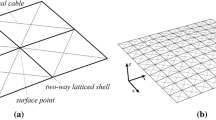Abstract
Cable-braced grid shells, being a new type of single-layer reticulated shell, are widely used in glass roofs. However, research on the shape optimization of free-form cable-braced grid shells is relatively lacking. This paper describes a shape optimization method for cable-braced free-form grid shells, with strain energy used as the optimization object, structural height used as the optimization variable, and the conjugate gradient method used as the optimization algorithm. According to the shape forming method for grid shells, their shape optimization can be realized only by adjusting the generatrix and directrix, not by optimizing the whole surface. The B-spline curve method is used to model the generatrix and directrix and maintain an optimized surface fairing. The following conclusions can be drawn from this study. First, the structural mechanical behavior of grid shells can be significantly improved with rapid convergence using the proposed shape optimization method. Second, the plane quadrilateral mesh is maintained and fewer optimization variables are needed during the proposed shape optimization method. Finally, the optimized surface is fairing and the mechanical properties of the optimized surface are somewhat decreased when using the B-spline curve method.
Similar content being viewed by others
References
Cui, C. Y. and Yan, H. (2006). “A morphosis technique for curved-surface structures of arbitrary geometries — Height adjusting method and its engineering applications.” China Civil Engineering Journal, 39(12), pp. 1–6 (in Chinese).
Fujita, S. and Ohsaki, M. (2009). “Shape optimization of free-form shells considering strain energy and algebraic invariants of parametric surface.” Proc. IASS, pp. 525–535.
Feng, R. Q., Ye, J. H., and Yao, B. (2012). “Evaluation of the buckling load of an elliptic paraboloid cable-braced grid shell using continuum analogy.” Journal of Engineering Mechanics, ASCE, 138(12), pp. 1468–1478.
Feng, R. Q., Yao, B., and Ye, J. H. (2013). “Stability of lamella cylinder cable-braced grid shells.” Journal of Constructional Steel Research, 88(9), pp. 220–230.
Hu, S. M., Lai, Y. K., and Yang, Y. L. (2008). “A Curvature flow based fairing algorithm of quad-dominant meshes.” Chinese Journal Of Computers, 31(9), pp. 1622–1628 (in Chinese).
Hayata, H., Kimura, T., and Ohmori, H. (2012). “Shape optimization of free formed shells considering buckling.” Proc. IASS, pp. 354–360.
Schlaich, J. (1999). “Schober H.Recent glass roofs.” Journal of the International Association for Shell and Spatial Structures, 40(3), pp. 193–205.
Glymph, J. and Shelden, D. (2004). “A parametric strategy for free-form glass structures using quadrilateral planar facets.” Automation in construction, 13(2), pp. 187–202.
Kimuru, T., Ohmori, H., and Hamada, H. (2007). “Computational morphogenesis of free form shells considering both designer’s preference and structural rationality.” Proc. IASS, pp. 360–368.
Li, X. and Wu, Y. (2007). “Grid shell-a new type of space structures.” Spatial Structures, 13(2), pp. 17–21.
Pigounakis, K. G. and Kaklis, P. D. (1996). “Convexitypreserving fairing.” Computer-Aided Design, 28(12), pp. 981–994.
Schober, H. (2002). Geometrie-Prinzipien für wirtschaftliche und effiziente Schalentragwerke. Bautechnik, Berlin (in German).
Schlaich, J. and Schober, H. (1997). “Glass roof for the Hippo House at the Berlin Zoo.” Structural Engineering International, 7(4), pp. 252–254.
Schlaich, J.(2004). “Conceptual design of light structures.” Journal of the International Association for Shell and Spatial Structures, 45(3), pp. 157–168.
Schlaich, J. and Schober, H. (2002). “Design principles of glass roofs.” Proc. International Symposium: Lightweight structures in Civil Engineering, Warsaw, Poland, Chapter 22, pp. 815–827.
Shi, F. Z. (2001). Computer-aided geometric design and non-uniform rational B-spline. Peking, Higher Education Press, Beijing, China (in Chinese).
Vizotto, I. (2010). “Computational generation of free-form shells in architectural design and civil engineering.” Automation in Construction, 19(2), pp. 1087–1105.
Winslow, P., Pellegrino, S., and Sharma, S. B. (2010). “Multi-objective optimization of free-form grid structures.” Structural and Multidisciplinary Optimization, 40(1–6), pp. 257–269.
Author information
Authors and Affiliations
Corresponding author
Additional information
Note.-Discussion open until February 1, 2014. This manuscript for this paper was submitted for review and possible publication on January 24, 2013; approved on June 29, 2013.
Rights and permissions
About this article
Cite this article
Feng, Rq., Ge, Jm. Shape optimization method of free-form cable-braced grid shells based on the translational surfaces technique. Int J Steel Struct 13, 435–444 (2013). https://doi.org/10.1007/s13296-013-3004-3
Published:
Issue Date:
DOI: https://doi.org/10.1007/s13296-013-3004-3




